Covid-19: How to Track a Virus in Wastewater
Wastewater’s biological clues provide an early warning system for COVID-19 outbreaks and other public health concerns.
Every day, people around the world flush valuable public health data straight down the toilet. Scientists have tested wastewater for community-level insights into substance use, nutrient levels, or harmful industrial chemicals.
Now, Kellogg Schwab, PhD, MSPH, and others are turning to the emerging field of “wastewater epidemiology” to recover evidence of COVID-19.
Although SARS-CoV-2 primarily infects the respiratory tract, the virus can also spread to the gut where the genetic material recovered from viruses present in fecal matter can be detected and isolated. Surveillance strategies that find these viral clues can offer early warning of outbreaks.
Schwab, an Environmental Health and Engineering professor, is now spearheading a twice-weekly surveillance and testing effort throughout 2021 at some of the 10 dorms at the University’s Homewood campus. “If we start to see ‘spikes’ [of SARS-CoV-2 RNA] in the waste stream signal, we can then go back and do more aggressive testing or quarantine,” he says.
A similar wastewater monitoring project was put in place by Ian Pepper, PhD, at University of Arizona dorms last summer. The advantage of monitoring wastewater, says the director of the university’s Water & Energy Sustainable Technology Center, is that detection of SARS-CoV-2 in this medium can precede onset of symptoms by up to a week.
“We were actually very effective in terms of catching people early in the infection process—often presymptomatic,” he says. “That enabled us to reduce exponential spread.” Since June, the program has helped detect and manage COVID-19 case spikes following holidays like Halloween and Thanksgiving, Pepper says.
Carsten Prasse, PhD, an assistant professor in Environmental Health and Engineering, sees numerous other opportunities for sewage-based surveillance beyond COVID-19. His research to date has focused on detecting drugs and other chemical contaminants in water, and Prasse recently collaborated on an effort to track opioid abuse in North Carolina via wastewater analysis.
“This community was interested in how many people were using [opioids], and what potential new drugs are coming in,” says Prasse, who is now exploring whether this approach could track biochemical signatures of malnutrition in food deserts in Baltimore.
In Arizona, Pepper sees opportunities to develop a more comprehensive and generalizable wastewater surveillance strategy for tracking future infectious disease outbreaks. “We're going after this concept of finding hot spots and providing an early warning system for health officials,” he says.
